REINFORCED CAD/CAM COMPOSITE FOR PERMANENT RESTORATION


REINFORCED CAD/CAM COMPOSITE FOR PERMANENT RESTORATION

This document provides scientific product information and answers to potential questions. The information is provided to COLTENE partners and customers free of charge and is intended for their internal use only. Although we confirm that the information is up to date and correct to our best knowledge we do not take any liability for the use of this information.
* VITA Enamic, VITA Suprinity, IPS Empress CAD, IPS e.max CAD, IPS e.max ZirCAD, Cerasmart, Lava Ultimate, Shofu Block HC, Syntac, Variolink, Clearfil Ceramic Primer, Ney-Oro CB, Empress 2, Procera Zirconia, RelyX Ultimate, Multilink, Nexus NX3, RelyX Unicem and Maxcem Elite are not registered trademarks of COLTENE.
Coltène/Whaledent AG

Feldwiesenstrasse 20
CH-9450 Altstätten / Switzerland
info.ch@coltene.com
HIGH PERFORMANCE – MADE BRILLIANT
BRILLIANT Crios is a reinforced composite for the fabrication of permanent, indirect restorations using a CAD/CAM grinding process. Three translucencies with a total of 15 shades offer a broad spectrum for aesthetic single-tooth restorations, both in the anterior and posterior regions. Together with excellent mechanical properties and a natural bite feeling, BRILLIANT Crios is the ideal CAD/CAM material for daily use in the dental practice.
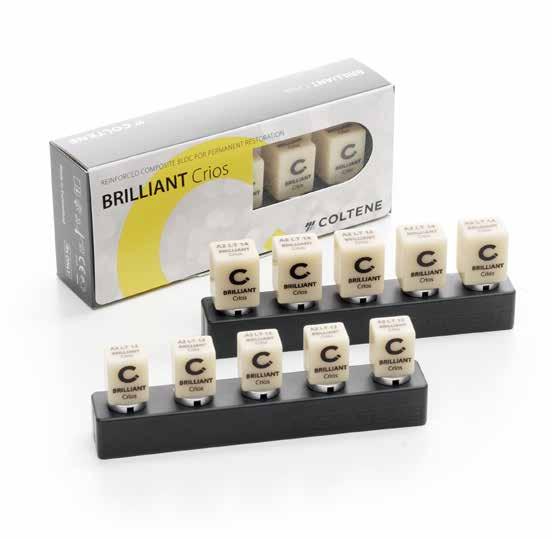
REINFORCED COMPOSITE
• High flexural strength for resistant restorations
• Tooth-like modulus of elasticity for a shock-absorbing effect and pleasant bite feeling
TOOTH-LIKE BEHAVIOUR
• Blends in extremely well to provide natural aesthetics
• High wear resistance and low abrasion on antagonist
EFFICIENT HANDLING
• No firing process required
• Can be modified and repaired
• Exceptional grinding precision for more freedom of preparation
• Effortless polishing for fast gloss
RELIABLE LUTING SYSTEM
• Secure bonding due to ONE COAT 7 UNIVERSAL
• Suitable luting material for every situation



BRILLIANT Crios is the ideal choice for single-tooth restorations, both in the anterior and the posterior region. This includes all conventional indications such as inlays, onlays, crowns and veneers. The shock-absorbing effect due to the dentine-like modulus of elasticity makes BRILLIANT Crios extremely well suited for implant restorations.



With 15 shades in three translucencies, BRILLIANT Crios offers a broad spectrum of colour shades.












Low Translucent
High Translucent

Super Translucent
Disc only available in certain shades.
BRILLIANT Crios is available as block (12/14) and disc (H14/H18).
The outstanding mechanical properties of BRILLIANT Crios are the result of controlled, stress-free, thermal curing. The multimodal composition of dental glass and amorphous silica in combination with a reinforcing resin matrix, make BRILLIANT Crios the ideal material for permanent single-tooth restorations.

Barium glass
Size < 1.0 µm
SiO2
Size < 20 nm
Cross-linked methacrylates
Inorganic pigments such as ferrous oxide or titanium dioxide

Method:
The samples were pretreated with 1000 grain abrasive paper. Scanning electron microscope (SEM) images were performed with and without metal vaporisation to display both the filler as well as the surface structure. The score marks facilitate the comparison of the same areas before and after metal vaporisation. The images of the non-metallised materials (A) give insights on the material, whereas the images of the metallised samples (B) reflect the surface structure.



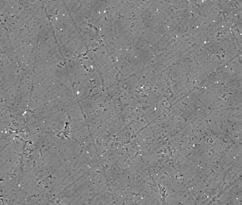




Conclusion:
Porosities can be detected in the case of IPS Empress CAD (IPS Empress CAD A). These porosities also exist on the surface (IPS Empress CAD B). Such porosities can be the starting point of fractures and lead to a reduction in flexural strength. In the case of Vita Enamic (Vita Enamic A), the porous ceramic (grey) can be observed infiltrated with polymer (dark spots). This clear differentiation between hard ceramic and polymer can lead to different rates of ablation for ceramic and polymer during the grinding or polishing process. This results in a rough surface (Vita Enamic B) which later on appears matt and leads to a lacklustre appearance of the restoration. In comparison, BRILLIANT Crios shows only small porosities. The surface structure (BRILLIANT Crios B) confirms this impression. This reduces the risk of fracture and makes the restoration more resistant.
Method:
Measuring flexural strength with the three-point method is the conventional method in the field of light-curing composites. The samples (1 × 1 × 18 mm) were cut wet with a diamond saw. The trimmed rods were then stored for 24 h at 37 °C in water. Measurement of flexural strength was performed after storage in water.
Conclusion:
The values measured for the three-point flexural strength correspond more or less to the values quoted in the literature and documentations. The high value for BRILLIANT Crios differs significantly from the other measured values. Based on this toughness, this suggests a material with very few faults. If a material has fewer faults this reduces the risk of fracture as faults may often be the starting point of fractures.
Method:
Rectangular platelets (thickness 1 mm) were sawn from the respective CAD/CAM blocks using a diamond saw. These were then converted to round specimens using a rotating diamond instrument. In the case of IPS e.max CAD, the specimens were fired according to the manufacturer's instructions. Prior to measurement (radius three-point base 3.9 mm) the samples were stored in water for 24 h at 37 °C.
Conclusion:
Compared with most materials, BRILLIANT Crios demonstrated a significantly higher biaxial flexural strength. Only lithium disilicate displays an even greater biaxial flexural strength. As with the three-point measurement, one can assume fewer faults here, which in turn reduces the risk of fracture.
Source: internal data
VITAEnamic*IPSEmpressCAD*IPSe.maxCAD* ShofuBlock* LavaUltimate* Cerasmart* BRILLIANTCrios

Method:
Measurement of the modulus of elasticity was performed using the three-point method. The samples (1 × 1 × 18 mm) were cut wet with a diamond saw. The trimmed rods were then stored for 24 h at 37 °C in water. Measurement of flexural strength was performed after storage in water.
Conclusion:
The value of the modulus of elasticity is greater the more resistance the material shows to deformation. A material with a high modulus of elasticity therefore possesses greater stiffness than a material of identical geometric dimensions with a lower modulus of elasticity. The E-modulus of dentine lies in the range of 10-20 GPa. If the E-modulus of the restoration is greater than that of the tooth substance, then this could lead to cracks in the restoration in case of deformation of the tooth substance.
Purely ceramic materials such as IPS Empress CAD demonstrate a considerably higher E-modulus in comparison to dentine. As a consequence of the lower modulus of elasticity of BRILLIANT Crios compared with ceramic, this affords better shock absorption of the masticatory pressure in comparison to materials with a greater E-modulus. This provides faster "chewing comfort" for the patient. Especially on crowns on implant abutments BRILLIANT Crios can absorb occurring peak loads better than ceramics with a very high modulus of elasticity.
Measured in GPa
Source: R. Böhner, M. Claude, C. Kopfmann. J Dent Res Vol 94 special Issue 94 B, #597
ShofuBlock* LavaUltimate* Cerasmart* BRILLIANTCrios
Method:
The CAD/CAM materials were polished in ascending order with SiC abrasive paper up to P4000. Mesio-buccal cusps of maxillary molars served as opposite teeth. The samples and opposite teeth were fixated in a computer-supported chewing simulator. The samples were loaded at a vertical load of 50 N as well as a lateral movement of 0.7 mm and 1.2 million chewing cycles. Simulation was performed at simultaneous thermal load in distilled water and alternating temperatures of 5 °C and 55 °C (60 s per cycle). Then all data sets prior to and after abrasion simulation were compared with 3D images.
Conclusion:
The high rate of abrasion of the opposite tooth is clearly visible for the purely ceramic material. Together with Lava Ultimate, Cerasmart and Shofu Block HC, BRILLIANT Crios proved to be very gentle on the opposite tooth. In terms of wear of the restoration material BRILLIANT Crios demonstrates a lower abrasion value, similar to that of ceramics. This means that the restoration is preserved for a long period and that existing tooth substance is protected as best possible.
VITAEnamic* IPSEmpressCAD* IPSe.maxCAD* ShofuBlockHC* LavaUltimate* Cerasmart* BRILLIANTCrios
Method: Wedges with a tapered tip up to 0.1 mm were ground wet in a Sirona inLab MC XL.
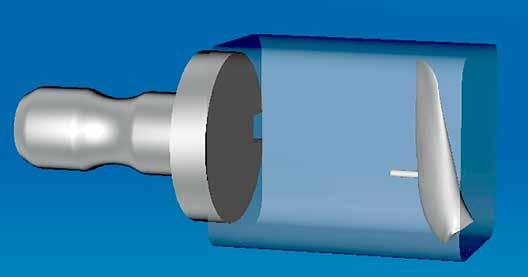
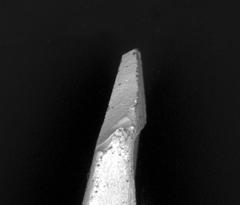

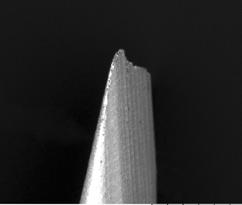

Conclusion:
Grinding without chipping is possible with BRILLIANT Crios. This enables improved marginal adaptation and a restoration more true in detail. This increases the final accuracy of fit.

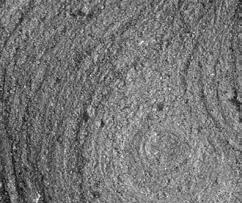


Method:
Posterior crowns were ground wet in a Sirona inLab MC XL grinding unit with a diamond step bur. Then the SEM images were taken without metallisation.
Conclusion:
Ceramic and non-ceramic materials display different microsections for the stages. The composite materials Lava Ultimate and BRILLIANT Crios display the exact grinding stages. This suggests less brittleness of these materials compared to ceramic.


Method:
Water sorption was determined according to ISO standard 4049: The samples were dried to a constant weight. Then the samples were stored in water, again to a constant weight. Water sorption is the difference in weight between the dried sample and the sample stored in water. The difference in weight is represented relative to the volume of the sample. Measurement of ceramic was dispensed with as it is not expected that purely ceramic materials can absorb water.
Conclusion:
BRILLIANT Crios and Cerasmart lie in the range of conventional composites such as, for example, BRILLIANT EverGlow. Due to its low polymer content, VITA Enamic shows low absorption of water.
The absorbed water can either fill porosities or be absorbed in the polymer matrix itself. If the polymer matrix absorbs water, this leads to an expansion of the material. If the expansion due to absorption of water is too high, particularly in the case of an inlay, this can exert considerable forces on the surrounding tooth substance. In the worst case, this can lead to cracks or complete fracture within the tooth substance.
Method:
The discolouration rate was investigated after 14 days of storage in cress, curry, red wine and distilled water. The materials were measured with a spectrophotometer (wavelength 400-700 nm). Then the ΔE value was calculated. ΔE values greater than 3.3 are regarded as being clinically noticeable.
Conclusion:
The lower the discolouration rate, the better and longer the overall aesthetic appearance will remain. The tendency to surface discolouration for BRILLIANT Crios is comparable to the values for Lava Ultimate, Cerasmart or Shofu Block HC. Clinically relevant discolouration can only be observed for curry and red wine. This is generally superficial discolouration. Many of the superficial deposits can be removed by caring for teeth with a toothbrush.
Rate of discolouration / ΔE value
Cress Red wine Curry Distilled water
Source: B. Stawarczyk, A. Liebermann, M. Eichberger, JF. Güth. J Mech Behav Biomed Mater 55, 1-11 (2015)
VITAEnamic* IPSEmpressCAD* IPSe.maxCAD* ShofuBlockHC* LavaUltimate* Cerasmart* BRILLIANTCrios
Method:
Crowns were produced according CEREC workflow with different occlusal thickness (0.5 mm, 1.0 mm and 1.5 mm) and adhesively luted to a core with an E-modulus of 2.5 GPa. Restorations were abraded with Si-coated aluminum oxide. Two groups (n = 10) were adhesively luted to the core, either with Syntac (Syn)* / Variolink (VL)* or with ONE COAT 7 UNIVERSAL (OC7U) / DuoCem (DC), respectively. Thermocycling and simultaneous mechanical load was applied (1.2 Mio loads with 49 N and 12.000 cycles between 5 °C and 55 °C). Finally, mechanical strength was tested by applying a mechanical load with a universal testing machine (crosshead speed 1 mm / min) in the central fossa of the crown using a ball geometry (diameter 12 mm).
Conclusion:
No values could be measured For VITA Enamic and VITABLOCS Mark II at 0.5 mm. Assuming a chewing force of 600 – 780 N, all thicknesses of BRILLIANT Crios may be appropriate for clinical use.
Sources:
– M. Zimmermann, A. Mehl. University of Zurich, Switzerland, Study Report to COLTENE 01/2017
– M. Zimmermann, G. Egli, M. Zaruba, A. Mehl. Dent Mater J. 36, 778-783 (2017)
– M. Zimmermann, A. Ender, G. Egli, M. Özcan, A. Mehl. Clin Oral Investig. Oct 27 (2018), published online
Method:
BRILLIANT Crios crowns were produced by COLTENE according the specifications of M. Menini. The restorations were placed in a masticatory robot to simulate human chewing and 100 masticatory cycles were performed, occluding with the flat upper surface of the robot. The maximum vertical force transmitted onto a simulated peri-implant bone was determined with following materials among others:
BRILLIANT Crios Ney-Oro CB * Empress 2 * Procera Zirconia *
Manufacturer COLTENE Dentsply Sirona lvoclar Vivadent Nobel Biocare
Material Class Composite Gold Alloy Silicate Ceramic Zirconia
E-Modulus/GPa 10.3 77 96 210
Conclusion:
No fractures of the samples occurred during the test. All BRILLIANT Crios crowns showed a shock-absorbing behavior similar to composite resin materials tested in previously published studies. BRILLIANT Crios showed up to 57 % lower stress transmission compared to zirconia, around 43 % less transmission than silicate ceramic and 19 % less compared to metal alloys.
Measured in N
Sources:
– M. Menini, University of Genova, Italy, Study Report to COLTENE 08/2017
– M. Menini, E. Conserva, T. Tealdo, M. Bevilacqua, F. Pera, A. Signori, P. Pera. lnt J Prosthodont 26, 549-56 (2013)
BRILLIANTCrios (Composite) (Metal)Ney-OroCB (SilicateEmpress2Ceramic) (Zirconia)ProceraZirconia
Method:
Molar sample crowns were prepared and divided into three groups, simulating different clinical procedures: Implant crown bonded to abutment (Chair), abutment and implant crown bonded in laboratory and screwed chairside (Lab), crowns bonded on human teeth (tooth). Combined thermal cycling and mechanical loading (TCML) was performed, simulating a 5-year clinical situation. And the end, fracture force was determined.
Conclusion:
Different results could be observed among the procedures. No debonding occurred during the TCML. The mechanical strength is high enough to withstand force peaks in posterior region, which are reported to be up to 900 N.
Method:
The samples were divided in four groups each undergoing different pretreatment procedures. Group 1 proceeded with air abrasion and using a resin primer (ONE COAT 7 UNIVERSAL) afterwards whereas Group 2 was also air abraded but using a silane primer afterwards (Clearfil Ceramic Primer*). Groups 3 and 4 were treated only with the resin primer and silane primer respectively and no air abrasion was done at all. After 24 h of water storage at 37 °C and 5000 thermo-cycles (5/55 °C), tensile bond strength was measured.
Conclusion:
An accurate pretreatment strategy is mandatory for creating reliable bond strength. Air abrasion as a pretreatment step resulted in superior bond strength compared to no air abrasion. Using a resin primer is also beneficial over using a ceramic primer.
Measured in MPa
Air abrasion + resin primer Resin primer
Air abrasion + silane primer Silane primer
Clin Oral Investig. 23, 529-538 (2019)
Method:
The adhesive bond between BRILLIANT Crios and resin based materials was tested using the Watanabe method. ONE COAT 7 UNIVERSAL was used as bonding agent.
Conclusion:
The better the bond, the lower the risk of debonding. The COLTENE luting materials demonstrate excellent bonding values in conjunction with BRILLIANT Crios and ONE COAT 7 UNIVERSAL. A cohesive fracture image was observed in all cases of COLTENE materials. This indicates a stable bond between the restoration material and the luting material as the fracture occurs over both materials. In contrast, an adhesive fracture image displays a fracture in the border region between restoration and luting material which indicates a poorer bond.
In contrast to pure ceramic materials, CAD/CAM composites must always be luted adhesively. This implies an adhesive bond between composite restoration and luting material as well as between luting material and tooth substance.
Depending on the indication, light-curing composites (stackable or flowable) or dual-curing resin cements (also referred to as "adhesive resin cement") are suitable. In the case of metallic or ceramic materials (abutments), self-adhesive resin cements are also suitable.
The term cement is often used in this context. Cement also includes materials such as zinc phosphate and glass ionomer cements or resin-reinforced glass ionomer cements. These cements are unsuitable for ensuring a permanent bond for a CAD/CAM composite restoration.
After fabrication of the restoration, the luting area to be bonded is sandblasted to enlargen the surface and to create mechanical retention. As sandblasting is a very abrasive process, care should be taken not to remove too much substance. Corundum (aluminium oxide) is used as blasting medium. Other blasting media such as sodium bicarbonate and glycine are not suited. The effect of the sandblasting procedure is comparable to pre-treatment through sandblasting for zirconia or etching with hydrofluoric acid for silicate ceramics. Depending on the material, both procedures lead to an enlarged surface and mechanical retention.
The sandblasted surface now contains particles of dental glass and polymerised resin matrix. The ratio is approximately 1:1. To ensure a permanent bond it is therefore important to achieve adhesion to both the glass as well as the resin matrix.
A: Silane (Si) is often used to provide adhesion to the dental glass filler (dark yellow). However, it has been shown that the use of silane does not result in optimal bonding across the entire surface in the case of BRILLIANT Crios, as the silane also wets the resin matrix (bright yellow) where it leads to impaired bonding.
B: Carboxylic acid groups or MDP (P/C) create a very good bond to the fillers. If these are combined with difunctional monomers, as in the case of ONE COAT 7 UNIVERSAL, a good bond to the resin matrix is generated.
A: Silane and luting material
B: ONE COAT 7 UNIVERSAL and luting material
Adhesion to the polymer matrix of the restoration can be divided into three types:
1.
The resin matrix of the CAD/CAM composite contains NH or OH groups. ONE COAT 7 UNIVERSAL also contains NH or OH groups. This allows the formation of hydrogen bonds between the resin matrix and adhesive, which leads to an improved bond between the CAD/CAM restoration and the adhesive.
2.
The bond is also improved by interlooping. Here, the monomers of ONE COAT 7 UNIVERSAL penetrate into the polymerised resin matrix of the restoration material. If these are polymerised, this leads to the formation of chains within the resin matrix of the restoration material which ideally leads to „interlooping“. The result is a mechanical bond.
Chain
The most important bond to the resin matrix is generated by chemical bonding to the polymerised resin matrix. The polymerised resin matrix of BRILLIANT Crios contains non-polymerised double bonds. Monomers of ONE COAT 7 UNIVERSAL penetrating the resin matrix link to these double bonds during polymerisation. This results in a polymer chain (chemical bond) which involves the molecules of the resin matrix of BRILLIANT Crios and ONE COAT 7 UNIVERSAL.
To ensure bonding to the tooth substance, a suitable bond has to be used, e.g. ONE COAT 7 UNIVERSAL. In the case of a light-curing bond, it is obligatory to light-cure according to the instructions for use after application, analogue to conventional filling therapy. Care should be taken that the luting material used is not too opaque, as not enough light may otherwise penetrate through the restoration to the uncured inhibition layer of the bond during final light-curing. In such cases, dual-curing or chemically curing bonds should be used.
Only resin based luting materials may be used for the adhesive luting of BRILLIANT Crios CAD/CAM composite restorations. This is the only way to guarantee an adhesive bond. Light-curing composites (e.g. BRILLIANT EverGlow), flows or veneer luting materials can be used as resin based luting materials. In this case care should be taken that sufficient light penetrates through the restoration to the luting material during the final curing process. The wall thicknesses of the restoration may therefore not exceed 3 mm.
If the wall thickness of the BRILLIANT Crios restoration exceeds 3 mm, dual-curing, resin based luting materials (e.g. SoloCem) must be used. These allow wall thicknesses up to a maximum of 5 mm.
If crowns are to be luted on titanium or ceramic abutments, self-adhesive luting materials (e.g. SoloCem) are suitable. Here too, the bond to the BRILLIANT Crios restoration must be generated with ONE COAT 7 UNIVERSAL.
Once the restoration is placed, final light-curing is performed. This cures ONE COAT 7 UNIVERSAL and the light-curing luting material. To achieve an optimal result, it is important to comply with curing times and light intensity.
Source: R. Böhner: Moderne CAD/CAM-Kompositmaterialien – deren Materialeigenschaften und Befestigungsstrategien.
In: ZMK (32)3 2016, p. 112–118.
1. What is BRILLIANT Crios?
BRILLIANT Crios is a reinforced composite for the fabrication of permanent, indirect restorations using a CAD/CAM process. BRILLIANT Crios is available in 15 different shades in Low Translucent, High Translucent and Super Translucent as well as in the different shapes block and disc.
2. What means reinforced composite?
BRILLIANT Crios undergoes a special production process which includes thermal curing. This “reinforcement” process leads to a very strong and tension free material. Compared to direct filling composites BRILLIANT Crios comes with much better mechanical properties, e.g. flexural strength and abrasion resistance.
3. How does BRILLIANT Crios differ from other materials on the market? In contrast to a lot of other CAD/CAM materials, BRILLIANT Crios is not made up of ceramic components, but consists purely of composite as known from direct filling therapy.
4. What are the advantages of BRILLIANT Crios?
BRILLIANT Crios offers exceptional mechanical properties. High flexural strength provides for resistant restorations. The modulus of elasticity, which is similar to dentine, allows for a shock-absorbing effect to reduce tension during masticatory load and provides the patient with a pleasant bite feeling. In addition, BRILLIANT Crios is highly abrasion-resistant. Nonetheless, the wear-resistant composite material proves to be especially kind on the antagonist teeth in comparison to ceramic restorations.
5. Which clinical situations is BRILLIANT Crios indicated for?
BRILLIANT Crios can be used for inlays, onlays, crowns and veneers. Due to its shock-absorbing effect, BRILLIANT Crios is particularly suited for implant-supported crowns.
6. Can BRILLIANT Crios be ground/milled both wet and dry?
The choice between wet and dry is only available for milling. Materials which are ground must always be processed wet. In general, BRILLIANT Crios can be ground or milled, depending on what the CAD/CAM device offers. COLTENE recommends using a wet grinding process to achieve best possible results.
7. Which burs are needed to process BRILLIANT Crios?
When grinding BRILLIANT Crios always use diamond burs. When BRILLIANT Crios is milled, diamond-coated milling cutters have to be chosen. To select the correct tools, it is suggested to refer to the device manufacturer’s recommendation.
8. Which shades are available for BRILLIANT Crios?
The shades of BRILLIANT Crios are VITA-based. Three translucencies with a total of 15 shades are available.
9. When to use which translucency?
Low Translucent shades are more opaque than High Translucent shades. They are therefore better suited for covering discolouration or on elder patients with a reduced enamel content. In contrast, High Translucent shades tend to adapt better to their surroundings due to increased light translucence. This leads to a better blend in effect, which is desirable for highly aesthetic outcomes. Super Translucent shades offer an excellent imitation of natural enamel and therefore are very suitable for veneers, table tops or split crowns.
10. With which bonding system must BRILLIANT Crios be used?
The ONE COAT 7 UNIVERSAL adhesive is matched perfectly to the BRILLIANT Crios components. This results in strong anchorage and a reliable bond to the restoration. This is why the ONE COAT 7 UNIVERSAL adhesive is to be used in conjunction with BRILLIANT Crios. The adhesive to the tooth substance can be chosen freely and can be performed with any suitable bond. (for further information, please see Product Guideline, Section on Adhesive Luting)
11. How must BRILLIANT Crios be pretreated?
Every material needs a pre-treatment to enlarge the surface and increase the retention. As BRILLIANT Crios is a composite material, sandblasting with 25-50 μm aluminium oxide must be performed beforehand to give reliable retention. Etching the restoration with hydrofluoric acid is not recommended, as this step would only dissolve the glass particles on the surface but not affect the resin matrix. BRILLIANT Crios does not require a firing process. Silane should also not be used as this reduces bonding to the resin matrix.
12. How must BRILLIANT Crios be luted?
The BRILLIANT Crios restoration is luted in the patient‘s mouth adhesively. The maximum wall thickness of the restoration is 5 mm for chemically curing luting materials and 3 mm for light-curing luting materials. Luting on tooth substance or composite can be performed with either light-curing composites (e.g. BRILLIANT EverGlow) as well as dual-curing resin cements (e.g. SoloCem). If the restoration is luted on metal or ceramic, a self-adhesive, dual-curing resin cement (e.g. SoloCem) is recommended. The luting surface of the BRILLIANT Crios restoration must always be bonded with ONE COAT 7 UNIVERSAL. A detailed step-by-step procedure is explained in the BRILLIANT Crios Handling Guideline.
13. Can BRILLIANT Crios be luted conventionally?
To ensure a reliable bond, BRILLIANT Crios may not be luted conventionally. BRILLIANT Crios may only be luted adhesively. Only ONE COAT 7 UNIVERSAL may be used as adhesive to the restoration.
14. Which polishing systems can be recommended?
The two-stage DIATECH diamond polishing system (Comprepol Plus and Composhine Plus, especially DIATECH ShapeGuard) is recommended for polishing. Polishing discs are recommended for interdental spaces.
15. Which preparation guidelines need to be observed?
16.
Please observe that BRILLIANT Crios is not subjected to direct sunlight or other sources of heat. The ideal storage temperature is 4–23 °C / 39–73 °F.
17.
BRILLIANT Crios be modified and repaired?
BRILLIANT Crios can be modified, characterised or repaired at any time. To this purpose, roughen the surface of the restoration using a diamond-coated rotary instrument. Bonding can be carried out using an adhesive suitable for this purpose (e.g. ONE COAT 7 UNIVERSAL). Then apply the shades for characterisation or composite (e.g. BRILLIANT EverGlow) for modification/repair. Always use resin based materials indicated for composite materials.
18. Which hardware and software conditions are required for processing BRILLIANT Crios?
BRILLIANT Crios is available as block (CEREC/inLab or Planmill mandrel) and disc (98.5 mm diameter) and is compatible with CAD/CAM devices supporting either the mandrel type or disc diameter. If the block/disc sizes or grinding or milling parameters are not available in the software settings of the CAD/CAM systems, they must be set in advance. To this purpose, please contact the corresponding CAD/CAM system provider.
©COLTENE – www.coltene.com
Coltène/Whaledent AG
Feldwiesenstrasse 20 9450 Altstätten / Switzerland
T +41 71 757 53 00
F +41 71 757 53 01 info.ch@coltene.com
Coltène/Whaledent GmbH + Co. KG
Raiffeisenstraße 30 89129 Langenau / Germany
T +49 7345 805 0
F +49 7345 805 201 info.de@coltene.com
Coltène/Whaledent Inc. 235 Ascot Parkway Cuyahoga Falls, Ohio 44223 / USA
T +1 330 916 8800
F +1 330 916 7077 info.us@coltene.com